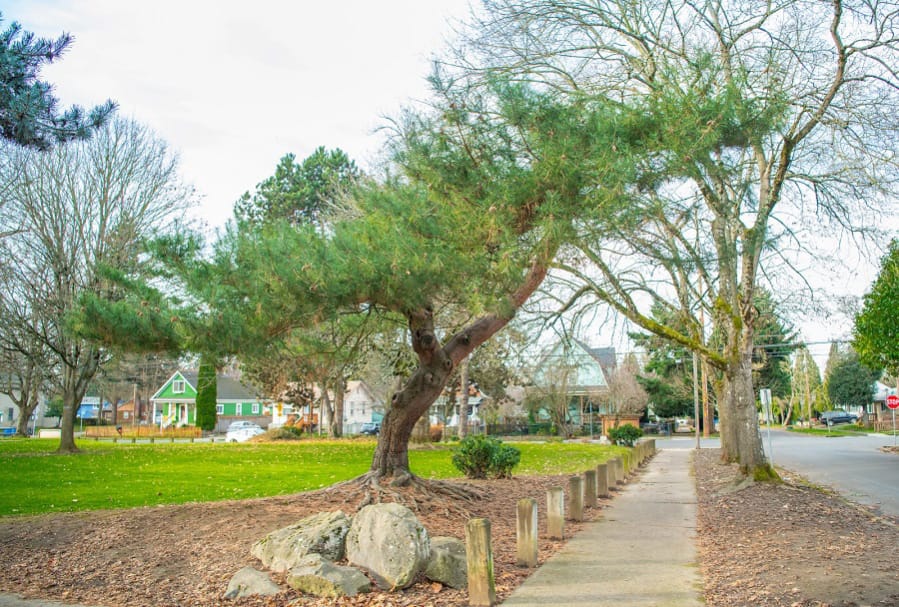Letter-writing has come back into fashion recently, an old-timey activity that’s regained its lost luster in this era of social distancing. Many people have taken up pen and paper to send handwritten words of love to friends and family. But how about writing letters to trees?
April is Arbor Month. Wednesday was Earth Day. To celebrate, Vancouver’s urban forestry program launched Letters to Trees, which encourages people to write letters to their favorite trees as though they were friends (and they are, in a way).
A similar program in Australia inspired Ash Lehto, a Vancouver AmeriCorps member, to suggest the idea.
It’s simple to participate. Write a letter to any tree you love — a tree in your backyard, or a tree you’ve noticed while rambling around your neighborhood. How about the Christmas tree in Esther Short Park that offers its branches, year after year, for a brilliant light show? How about a tree that has provided shade on a hot day, a shower of blossoms in spring, or a fiery show of colors in autumn? How about a fruit tree that has given you apples for pie or plums for jam?
“People have stories about trees over years and over generations, because they have really connected with them,” said Jessica George, Vancouver’s urban forestry outreach coordinator. “You have an opportunity to get out and think about what trees are around you.”
For extra inspiration, check out the city’s map of heritage trees online. It shows the location of special trees all over the city with pictures and information about each tree’s type and history.
The map includes the 150-year-old western white pine on the Old Evergreen Highway, the London planetree in the Lincoln neighborhood, the rare scarlet oak on West 21st Street, the giant sequoia in the Parkside neighborhood, as well as the towering black locust at Mill Plain Elementary School, planted by a teacher in the early 1900s as an Arbor Day project.
The city’s most famous heritage tree, the beloved Old Apple Tree in Fort Vancouver’s Old Apple Tree Park, took root in 1826 and survived high winds, floods and urbanization. When the Spanish flu pandemic came to Vancouver in 1918, the Old Apple Tree was there, keeping watch. This great-great-great grandmother of trees is celebrated every year with the Old Apple Tree Festival on the first Sunday in October.
The Old Apple Tree, in fact, is George’s favorite (if she had to choose).
“It has withstood such adversities. It’s had such a long and storied life,” George said. “It’s amazing that it’s still producing flowers. It’s pretty special.”
Can’t choose just one tree? How about a grove?
“There are several groves in our inventory,” said George, citing the conifer grove in Esther Short Park and the regal trees that line Officers Row. “There are two amazing giant sequoias in front of Ellsworth Elementary that are just beautiful and majestic.”
Your favorite tree, however, might be the one right outside your window.
“Heritage trees are fantastic and special and they have stories, but right now we really want to encourage people to follow the directive to stay home,” George said. “If there’s a tree in your yard or a tree you can see out your window, that’s an opportunity to sit with that tree and be artistic and creative.”
Letters can be as long or as short as you like, and can include poems, drawings or photographs. They can be written in any language and letter-writers don’t have to be residents of Vancouver.
When your letter is ready, email it to letterstotrees@cityofvancouver.us; artwork can be scanned or photographed and included as a PDF. Finally, you don’t have to submit your letters during Arbor Month. Vancouver is offering this as a year-round program.
Every month, a few letters will be shared in Vancouver’s urban forestry newsletter or as part of other outreach programs. To sign up for the newsletter, email urbanforestry@cityofvancouver.us.
To learn even more about trees, visit the urban forestry program’s “Treeducation Station” at www.cityofvancouver.us/publicworks/page/treeducation-station. This page has family-friendly videos, activity suggestions and downloadable puzzle books.
This project might also inspire you to nominate your favorite tree to join the ranks of local heritage trees. To review the criteria, visit www.cityofvancouver.us/publicworks/page/heritage-trees and follow the guidelines for submission.




